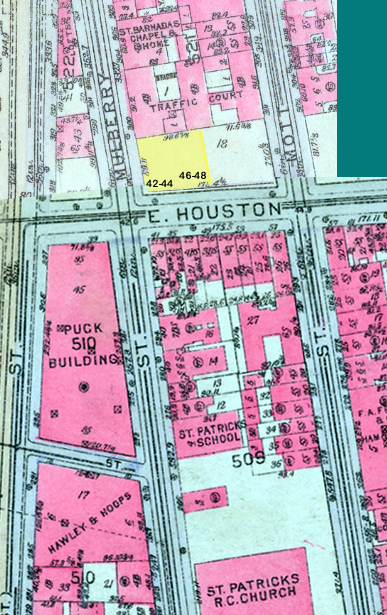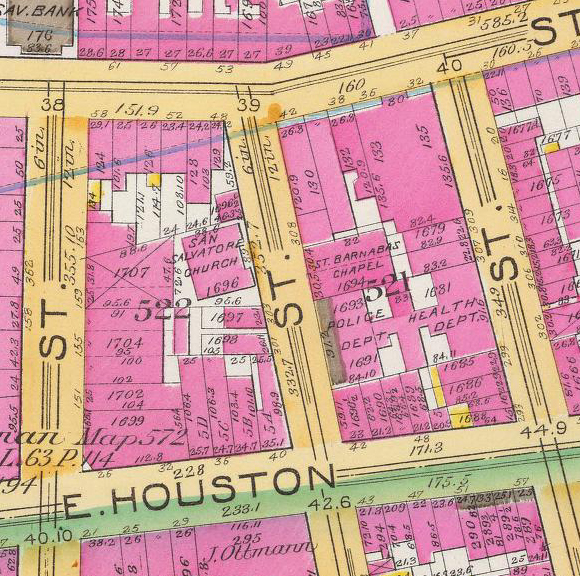I
decided to continue my search for photos of the buildings which housed
Tesla's labs by looking for photos of nearby buildings, in particular by Googling adjoining addresses. In doing so I've come across a good, clear photo of his East Houston
Street laboratory building.
Tesla
moved into the sixth and seventh floors of 46-48 East Houston in July, 1895 after his previous laboratory on
South Fifth Avenue burned down. His Houston Street lab was the last address that is referred to as a laboratory in Manhattan in his Carlson biography. As demonstrated in a previous post, the Houston Street laboratory building was torn down in 1929 when Houston Street was widened and a subway line was installed beneath the street.
East Houston Street, September 26, 1929. Parcels 45 to 49, (622) R.103 S.1. Subway Construction Photograph Collection. New York Historical Society #83675d.
This photo was found at the New York Historical Society Tumblr page and will be referred to below as the September 1929 photo.
Pondering this photo I thought, wait a minute: they tore down both sides of E. Houston in 1929? Answer: No, they didn't. The Puck Building on the southwestern corner of Mulberry and East Houston is still standing. Could they have torn down a few buildings on the south side? Or was this photo mislabeled?
The 1930 G.W. Bromley Atlas divided E. Houston, north and south, into two different plates. Below is a composite. Note the disappearance of the buildings on the north side and the presence of the buildings on the south side.
From: Plates 23 and 19, Land Book, City of Manhattan, G.W. Bromley & Co, New York, 1930, New York Public Library. The sites of two buildings comprising 42-44 and 46-48 East Houston are marked and highlighted in yellow. By 1930, these were part of a vacant lot.
Below is a photo of the south side of East Houston between Mott and Mulberry and on to the Puck Building. These buildings were not demolished. The photo is from June 3, 1933.
From: New York Public Library Digital Collections, Image ID 719461F. South side of East Houston looking west from Mott, including the corner of Mulberry and the Puck Building.
1934 photograph of the former police headquarters at 300 Mulberry looking across East Houston after East Houston had been widened. Note the two-toned building in the middle of the block, marked by an arrow. This corresponds to the building on the right side of the September 1929 photo.
If
the September 1929 photo was the north side of East Houston and,
indeed, Tesla's laboratory, it would have been taken from the
southwestern corner of Mott and East Houston (note the presence of a street sign in the upper right corner) and looking northwest. So, was this the case? The first clue I noticed is the One Way sign. If this is indeed the north side of the street and Tesla's lab then East Houston at this time was one way going
west. The photo below looks from Elizabeth Street west down East Houston and includes Mott and, incredibly, the site of Tesla's laboratory, the taller building in the left upper corner (marked by an arrow).
From: New York Public Library Digital Collections, Image ID 719463F. This photo is helpfully labelled: East Houston Street, north side, west from Elizabeth Street, to but not
including Mulberry, after crossing Mott Streets. Also shown (right) are
Nos. 281 to 285 Elizabeth Street, at, adjoining and north of the N.W.
corner of East Houston Street. These houses were later demolished to
facilitate the construction of the Independent System Subway (Eighth
Ave. subway); their site is now (1937) being used as a playground and
Park.
July 17, 1929.
Note that you can see the rear ends of cars along East Houston, pointing west. Therefore East Houston was One Way, going west.
Photoshopped image of the street sign in the September 1929 photograph showing E Houst[on] and Mott.
Below is another photograph of the north side of East Houston between Mulberry and Mott although it mostly focuses on the west side of Mott. The building prominent and in the center is the back side of the former police headquarters which at one time extended from Mulberry to Mott. This corresponds well to the above 1934 photo of the police headquarters after the widening of East Houston. Note the two-toned building and the white ghosts of bricked-over windows. The tall building on the left hand side of the photograph is Tesla's laboratory, although only brick can be seen.
From: New York Public Library Digital Collections, Image ID 721774F. Mott Street (where the car is parked) looking northwest across East Houston.
Previously:
Tesla's Houston Street Laboratory
Tesla's Grand Street Laboratory
Tesla's South Fifth Avenue Laboratory
Tesla's Liberty Street Laboratory

Martin Hill Ortiz, also writing under the name, Martin Hill, is the author of A Predatory Mind. Its sequel, set in 1890s Manhattan and titled A Predator's Game, Rook's Page Publishing, features Nikola Tesla as a detective.
A Predator's Game is available in soft-cover and ebook editions through Amazon and other online retailers.
His recent mystery, Never Kill A Friend, is available from Ransom Note Press. His epic poem, Two Mistakes, recently won second place in the Margaret Reid/Tom Howard Poetry Competition. He can be contacted at mdhillortiz@gmail.com..








































